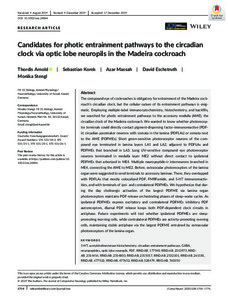| dc.date.accessioned | 2020-05-20T06:26:10Z | |
| dc.date.available | 2020-05-20T06:26:10Z | |
| dc.date.issued | 2019-12-20 | |
| dc.identifier | doi:10.17170/kobra-202005081235 | |
| dc.identifier.uri | http://hdl.handle.net/123456789/11563 | |
| dc.description.sponsorship | Gefördert im Rahmen des Projekts DEAL | |
| dc.language.iso | eng | |
| dc.rights | Namensnennung 4.0 International | * |
| dc.rights.uri | http://creativecommons.org/licenses/by/4.0/ | * |
| dc.subject | 5-HT | eng |
| dc.subject | acetylcholinesterase histochemistry | eng |
| dc.subject | circadian entrainment pathways | eng |
| dc.subject | GABA | eng |
| dc.subject | neuropeptides | eng |
| dc.subject | optic lobe neuropils | eng |
| dc.subject | PDF | eng |
| dc.subject | RRID:AB_177540 | eng |
| dc.subject | RRID:AB_2313973 | eng |
| dc.subject | RRID:AB_2314414 | eng |
| dc.subject | RRID:AB_2314803 | eng |
| dc.subject | RRID:AB_2315017 | eng |
| dc.subject | RRID:AB_2532101 | eng |
| dc.subject | RRID:AB_261181 | eng |
| dc.subject | RRID:AB_477522 | eng |
| dc.subject | RRID:AB_477652 | eng |
| dc.subject | RRID:AB_528479 | eng |
| dc.subject | RRID:AB_760350 | eng |
| dc.subject.ddc | 570 | |
| dc.title | Candidates for photic entrainment pathways to the circadian clock via optic lobe neuropils in the Madeira cockroach | eng |
| dc.type | Aufsatz | |
| dcterms.abstract | The compound eye of cockroaches is obligatory for entrainment of the Madeira cockroach's circadian clock, but the cellular nature of its entrainment pathways is enigmatic. Employing multiple‐label immunocytochemistry, histochemistry, and backfills, we searched for photic entrainment pathways to the accessory medulla (AME), the circadian clock of the Madeira cockroach. We wanted to know whether photoreceptor terminals could directly contact pigment‐dispersing factor‐immunoreactive (PDF‐ir) circadian pacemaker neurons with somata in the lamina (PDFLAs) or somata next to the AME (PDFMEs). Short green‐sensitive photoreceptor neurons of the compound eye terminated in lamina layers LA1 and LA2, adjacent to PDFLAs and PDFMEs that branched in LA3. Long UV‐sensitive compound eye photoreceptor neurons terminated in medulla layer ME2 without direct contact to ipsilateral PDFMEs that arborized in ME4. Multiple neuropeptide‐ir interneurons branched in ME4, connecting the AME to ME2. Before, extraocular photoreceptors of the lamina organ were suggested to send terminals to accessory laminae. There, they overlapped with PDFLAs that mostly colocalized PDF, FMRFamide, and 5‐HT immunoreactivities, and with terminals of ipsi‐ and contralateral PDFMEs. We hypothesize that during the day cholinergic activation of the largest PDFME via lamina organ photoreceptors maintains PDF release orchestrating phases of sleep–wake cycles. As ipsilateral PDFMEs express excitatory and contralateral PDFMEs inhibitory PDF autoreceptors, diurnal PDF release keeps both PDF‐dependent clock circuits in antiphase. Future experiments will test whether ipsilateral PDFMEs are sleep‐promoting morning cells, while contralateral PDFMEs are activity‐promoting evening cells, maintaining stable antiphase via the largest PDFME entrained by extraocular photoreceptors of the lamina organ. | eng |
| dcterms.accessRights | open access | |
| dcterms.creator | Arnold, Thordis | |
| dcterms.creator | Korek, Sebastian | |
| dcterms.creator | Massah, Azar | |
| dcterms.creator | Eschstruth, David | |
| dcterms.creator | Stengl, Monika | |
| dc.relation.projectid | Deutsche Forschungsgemeinschaft. Grant Numbers: STE 531/18‐3, STE 531/21‐1, STE 531/25‐1, STE 531/26‐1 | |
| dc.subject.swd | Küchenschabe | ger |
| dc.subject.swd | Tagesrhythmus | ger |
| dc.subject.swd | Nervensystem | ger |
| dc.type.version | publishedVersion | |
| dcterms.source.identifier | EISSN 1096-9861 | |
| dcterms.source.issue | Issue 10 | |
| dcterms.source.journal | JCN The journal of comparative neurology | eng |
| dcterms.source.pageinfo | 1754-1774 | |
| dcterms.source.volume | Volume 528 | |
| kup.iskup | false | |


